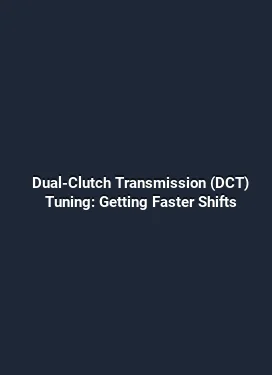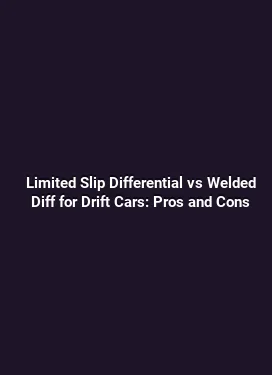Carbon Fiber Driveshaft vs Aluminum Driveshaft: Weight and Strength
Drivetrain efficiency is a cornerstone of modern vehicle performance, especially in applications where weight savings translate directly to acceleration, handling, and fuel economy. The driveshaft, a seemingly simple component, plays a pivotal role in delivering torque from the transmission to the differential while enduring high rotational speeds and varying loads. Two materials dominate the landscape: carbon fiber (often referred to as CFRP in technical channels) and aluminum. Each offers a distinct combination of weight, stiffness, fatigue life, and durability. This analysis delves into how these materials compare in real-world driving scenarios, with a focus on weight and strength, and includes practical takeaways for enthusiasts, racers, and professional tuners.
Understanding the core differences: weight, stiffness, and load paths

Weight reduction in drivetrain components is a powerful lever for improving responsiveness and efficiency. Carbon fiber driveshafts typically provide a significant weight advantage over aluminum equivalents. A CFRP driveshaft can be a fraction of the mass of an aluminum shaft of the same length and diameter, reducing unsprung weight and rotational inertial mass. This reduction translates to quicker throttle response, improved drivetrain efficiency, and a smoother engine inertia profile when shifting and accelerating. However, the specific benefits depend on wall thickness, layup, and the number of plies in the carbon fiber structure. Aluminum shafts, while heavier, bring a familiar and predictable behavior under load and can be more forgiving in certain heat and vibration scenarios.
Beyond sheer weight, stiffness and the way torque travels along the shaft matter. Carbon fiber offers high torsional stiffness in a lightweight package, which helps minimize shaft twist under load and improves rotational stability. The result can be crisper throttle feel and more consistent power delivery, especially in high-torque applications. Aluminum, though heavier, provides adequate stiffness and strength with a more uniform, isotropic response. The trade-off is that the same torque input can induce greater angular deflection if the shaft is designed with a thicker wall or larger diameter to compensate for the material’s lower specific stiffness. Understanding this balance is essential when selecting a driveshaft for a specific vehicle performance target.
Weight considerations: how much difference does it make?
The lightness of carbon fiber stems from its high strength-to-weight ratio. In practical terms, a CFRP driveshaft can shave tens of percent off the weight of a comparably sized aluminum unit. This weight savings not only lowers rotational inertia but also reduces the parasitic energy losses associated with accelerating and decelerating a heavy rotating mass. For high-revving engines and gearboxes with short gearing, the benefits accumulate rapidly as engine RPM climbs and shifts occur more frequently. In street applications, the perceived improvement often shows up as smoother launches and a more linear power curve, especially when the drivetrain is paired with performance-oriented gearing.
Nevertheless, weight alone does not tell the full story. The way the driveshaft is manufactured—fiber orientation, resin system, and bonding methods—affects how its mass participates in resisting torsion. A well-designed CFRP shaft leverages the directional stiffness of carbon fiber to create a lightweight member that resists twist along its length. Aluminum shafts, while heavier, can be designed with uniform cross-sections that produce reliable stiffness characteristics across typical operating ranges. In practical terms, a well-matched aluminum shaft can offer a predictable torque path with less susceptibility to subtle changes in temperature or environmental conditions that influence composite materials.
Strength and fatigue life under real-world loads
Strength in this context refers to the ability of the driveshaft to withstand peak torques without failure, while fatigue life describes how many cycles of loading it can endure before signs of wear or failure appear. Carbon fiber shines in peak performance scenarios where a high torsional stiffness-to-weight ratio is advantageous. When properly engineered, a CFRP driveshaft can resist torsional stress with minimal elongation, helping to maintain consistent gear engagement under aggressive driving. However, composites can be sensitive to impact damage and environmental exposure. Small surface cracks or flaws in the resin matrix, if not detected, can propagate under cyclic loading, potentially reducing life expectancy. Protective finishes, proper kitting, and careful handling during installation are essential to maximize durability.
Aluminum shafts typically exhibit excellent resistance to impact and damage from road debris, with predictable performance across a range of temperatures. The material’s ductility allows it to absorb energy from sudden shocks without catastrophic failure, a trait that can be advantageous in rough-road or endurance racing environments. Fatigue behavior in aluminum is well understood, and designers can use conservative cross-sections to ensure longevity under repeated torque applications. The trade-off is a heavier mass, which translates into higher inertia but often more consistent behavior when subjected to extreme, repetitive loads.
Vibration, noise, and harshness (NVH) implications
NVH performance is a practical consideration for everyday driving and high-performance setups alike. Carbon fiber’s damping characteristics can be tailored through layup choices and resin systems. In some configurations, CFRP driveshafts exhibit lower vibrational transmission and reduced harmonic content at certain RPM ranges, contributing to a smoother ride and improved driver feedback. On the flip side, carbon fiber can be more sensitive to impact-induced defects that alter its stiffness, potentially introducing atypical NVH signatures if damaged.
Aluminum driveshafts interact with mounting points and the surrounding structure differently. They can generate higher-frequency vibrations at certain RPMs due to their metal mass and resonance modes. Engineers address this with careful balancing, appropriate engine and exhaust mounting, and vibration-damping inserts where needed. For drivers seeking a quiet, refined feel at highway speeds, aluminum shafts may offer consistent NVH characteristics, while carbon fiber configurations can be tuned to deliver a more responsive, performance-oriented experience when designed specifically for the vehicle’s dynamics.
Durability and environmental considerations
Durability in a driveshaft depends on the intended use, climate, and maintenance regimen. CFRP components are typically highly resistant to corrosion and can offer strength advantages with lower weight. However, exposures to high heat, chemicals, or UV light without proper protective coatings can affect resin integrity over very long service intervals. In performance motorsports environments, carbon fiber components are often protected with durable coatings and subject to regular inspections for micro-cracks, delamination, or impact damage from debris.
Aluminum driveshafts are inherently robust in many scenarios, resisting corrosion and tolerating a broad range of environmental conditions. They can suffer from fatigue at critical stress points if not correctly designed, but the materials and manufacturing processes are well established. The durability of an aluminum driveshaft is frequently tied to its cross-sectional design, balancing stiffness and weight while providing a margin against impact-related failures in rough operating environments.
Manufacturing, cost, and lifecycle considerations
The cost landscape for driveshafts reflects material, manufacturing complexity, and projected lifecycle. Carbon fiber shafts typically come with higher upfront costs due to the complexity of layup processes, curing cycles, and quality control requirements. For enthusiasts and race teams, the higher price is often justified by weight savings, performance gains, and the ability to tailor stiffness through layup patterns. In some cases, CFRP driveshafts enable smaller or lighter powertrain components elsewhere in the vehicle, amplifying the overall performance package.
Aluminum driveshafts generally present lower initial costs and shorter lead times. The manufacturing process is mature, scalable, and widely available, making it a pragmatic choice for many vehicle programs. The lifecycle cost for aluminum may be favorable in applications where maintenance, inspection, and durability under rough conditions are paramount. At the same time, the weight penalty can influence fuel economy, acceleration, and braking performance, particularly in lighter or high-revving platforms.
Practical guidance: selecting the right driveshaft for a given build
Choosing between carbon fiber and aluminum should be driven by a holistic view of the vehicle’s purpose, power output, and operating environment. For track-focused builds where weight reduction and precise throttle response are critical, a carbon fiber driveshaft designed with the correct ply orientation can deliver meaningful gains in rotational efficiency and steering feel. For daily drivers or off-road applications where durability and long-term reliability take precedence, an aluminum driveshaft may offer robust performance with a more straightforward maintenance path.
Key factors to evaluate include the motor’s torque curve, transmission gear ratios, drivetrain geometry, and the vehicle’s suspension tuning. Additionally, consider serviceability: carbon fiber shafts may require specialized inspection techniques to detect inner delamination, while aluminum shafts typically rely on standard visual inspection and balancing procedures. The choice should align with the overall tuning strategy, ensuring the driveshaft complements the engine output, differential characteristics, and chassis dynamics.
Installation and maintenance best practices
Whether selecting CFRP or aluminum, installation must prioritize exact balancing, proper spline engagement, and secure mounting. Imbalances can amplify vibrations, wear bearings, and shorten component life. For carbon fiber shafts, commissioning a certified technician to perform static and dynamic balancing is advisable, given the precision required to avoid misalignment that could introduce or magnify harmonic issues. Balancing limits, runout tolerances, and proper anti-corrosion hardware help maximize longevity.
Maintenance involves routine inspection for signs of wear or damage. Carbon fiber variants should be checked for resin cracks, ply separation, or surface damage that could compromise stiffness. Aluminum shafts warrant inspection for bending, denting, or corrosion at critical joints and mounting points. In both cases, follow the vehicle manufacturer’s guidance regarding inspection intervals and replacement criteria, especially in high-stress driving scenarios like competitive events or aggressive track sessions.
Applications across vehicle types
Performance cars, racing platforms, and high-end tuned street machines often push the envelope where the benefits of light-weight, stiff driveshafts become more pronounced. A CFRP driveshaft is commonly found in applications where rapid torque delivery and reduced inertial loads contribute to sharper acceleration and more predictable shifts. In endurance racing or heavy-tull torque setups, aluminum may be preferred for its resilience and simpler serviceability under harsh conditions. The decision also hinges on compatibility with existing drivetrain components, including universal joints, slip yokes, and the transmission output shaft, ensuring a cohesive and reliable torque path.
Ultimately, the best choice is the one that coherently integrates with the vehicle’s target dynamics, balancing weight savings with durability, NVH preferences, and maintenance expectations. For engineers and technicians, the emphasis is on a well-documented specification, precise installation, and an ongoing monitoring plan to verify that performance gains persist over time and across a range of operating temperatures and loads.
Manufacturing nuances and performance nuances

In carbon fiber driveshafts, the orientation of the carbon plies relative to the shaft axis is critical. Tailoring the weave and layering can optimize torsional stiffness while preserving a favorable weight profile. The resin system and cure cycle influence temperature resistance and long-term stability, making quality control a central pillar of reliability. In aluminum driveshafts, the cross-section geometry, such as hollow versus solid designs, affects both stiffness and weight distribution. Efficient heat dissipation and corrosion protection also factor into long-term performance, particularly in high-heat environments or salted road conditions.
From a performance perspective, the interaction with the transmission and drivetrain controls matters. A well-muned driveshaft should complement the vehicle’s torque management strategy, transmission shift logic, and differential behavior, contributing to a coherent driving experience rather than an isolated improvement in one metric. This holistic approach helps ensure that benefits are realized across a broad spectrum of driving conditions, including everyday cruising, spirited street driving, and competitive events.
Bottom-line takeaways for enthusiasts and professionals
Weight reduction in the driveshaft can yield tangible improvements in throttle response, acceleration, and overall vehicle agility. Carbon fiber offers substantial weight savings and high stiffness, which can translate into sharper dynamics and reduced rotational inertia when designed and installed correctly. Aluminum driveshafts bring robust durability, predictable behavior, and lower upfront costs, making them a reliable choice for many enthusiasts and professional teams.
Practical decision-making should center on an integrated view of total vehicle performance goals, maintenance expectations, and budget. A detailed assessment of torque requirements, operating temperatures, environmental exposure, and serviceability will illuminate which material better aligns with the build’s objectives. By aligning material choice with the intended use and ensuring high-quality installation and inspection practices, the drivetrain can deliver consistent, repeatable performance without compromising reliability or daily usability. Frequently Asked Questions






